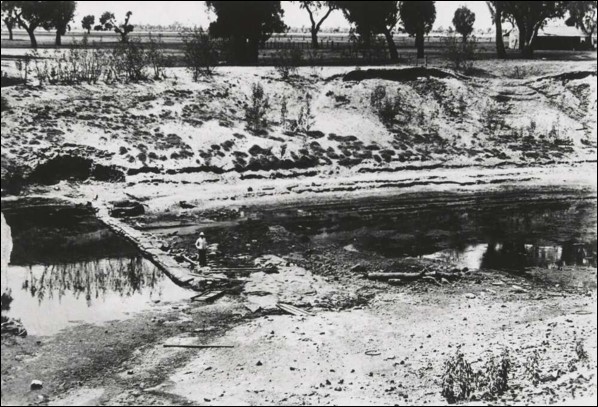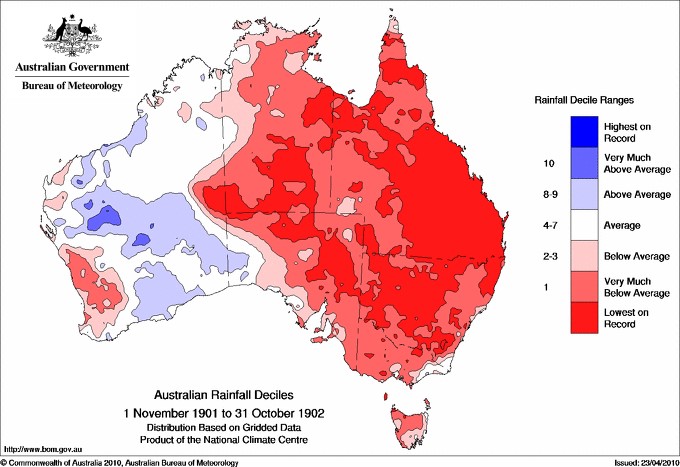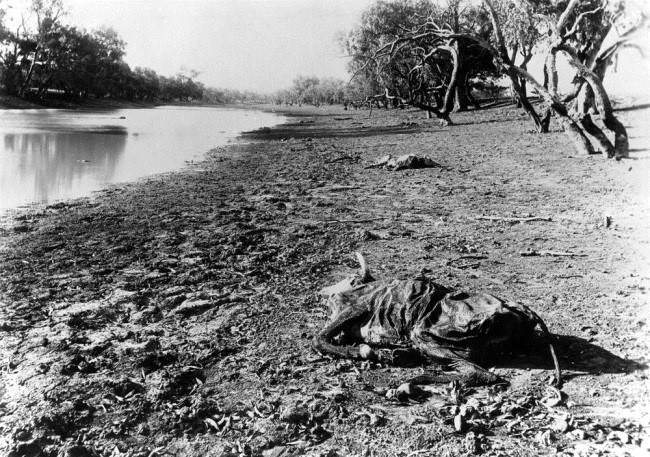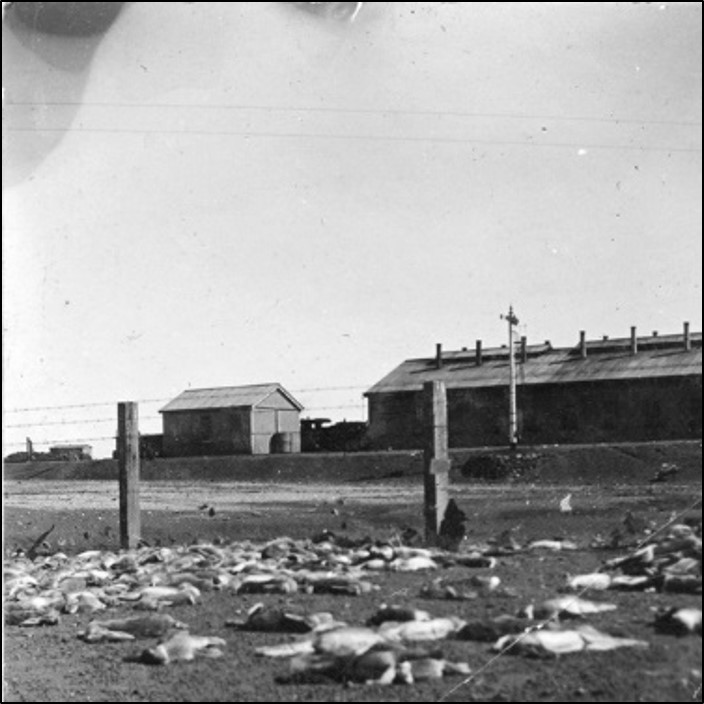
An extremely low water level in the Darling River in Wilcannia, 1902. Source: National Library of Australia
Australia is a continent defined by extremes. Recent years have seen devastating scenes of blistering heat, historic low rainfall and drought across central and eastern Australia.
But what can droughts tell us about the future? Ecologists have reconstructed Australia’s Federation Drought (1895 to 1903) to explore how megadroughts affect Australian ecosystems. They found that droughts could lead to a possible ecosystem collapse without any mitigation from us.
‘Once in a century’ drought
The Federation Drought is thought to be one of the most severe droughts in European recorded Australian history. Much of the country received less than 40 per cent of its average rainfall. 1902 was also our driest year on record.
“In NSW, most rivers stopped flowing. Dust storms filled dams, buried homesteads and created ghost towns as people fled,” said our lead researcher Dr Robert Godfree.
But little was known about the Federation Drought’s ecological impacts.
With the availability of recently digitised archival newspaper reports, ecologists reconstructed the events of the Federation Drought to measure its impact on biodiversity. They found that the Federation Drought had the biggest impact on plants and animals across the continent since records began.

Australian Rainfall Deciles from November 1901 to October 1902. Source: BOM
Mass loss
To reconstruct the Federation Drought, our scientists studied historical newspaper articles from the National Library of Australia.
“We overlaid this with historical rainfall records, and we travelled to the severely impacted areas. We were also able to refer to CSIRO’s National Research Collections Australia to determine what was impacted,” Dr Godfree said.
This allowed researchers to clearly visualise what conditions were like in 1902, and their effects on biodiversity.
“More than 60 bird, fish, mammal, reptile, and plant genera (species) were severely affected across over a third of Australia,” he said.
“Wildlife and stock starved or died of thirst. Native birds and mammals died under trees, in creeks, and on the plains. Tens of millions of sheep were killed. Hundreds of millions of rabbits died of starvation after stripping the landscape of its plant life,” he said.
“Herbivores, grain-eating birds, fish and plants were most vulnerable, while predators who could feed on dead animals, and other groups like waterbirds which could travel long distances, were less impacted,” Dr Godfree said.

A cow carcass close to the river. Many stock starved or died of thirst during the Federation Drought. Source: National Library of Australia
Changing landscape, changing climate
Australia’s national climate projections indicate that, over the coming decades, we will experience more time spent in drought. And researchers warn that an increase in such drought events could be devastating for global biodiversity.
“With many of Australia’s landscapes more fragmented and degraded than in the 1800s, and species under pressure from invasive plants and animals, a similar drought today could spell disaster on an even more devastating scale than seen in the Federation Drought,” Dr Godfree said.
“Right now we need to focus on maintaining healthy ecosystems as an insurance against drought impacts,” he said.
This is why we need a plan.

Hundreds of millions of rabbits died of starvation after the drought decimated the land of greenery. Source: National Library of Australia
Dealing with drought
But it’s not all doom and gloom. Our researchers are using this data to work on ways we can prepare for, and adapt to, the impacts of future droughts. This ranges from new agriculture practices and drought-tolerant plants through to a better understanding of the science of climate change and water resources.


19th July 2019 at 9:14 pm
Techno fixes have their role to play in our adaptation to the changes that are happening
I believe that we have to adapt our thinking and as a result our ways of living here
Such changes took place towards the end of the last long drought
Unfortunately we haven’t sustained our efforts to today
19th July 2019 at 4:58 pm
I think the drought effects are telling us what we already know, that drought is a normal part of our climate.
Also the effects are telling us what we should know but maybe won’t acknowledge, that without the original ground cover our wonderful country is destined to blow and decay away until most of it’s life is extinguished!
It tells us that we must cover all the bare ground with trees, shrubs or other perennials, able to recover after the bad times, we must rid the country of feral camels, pigs, donkeys, horses, rabbits, and that our cleared land needs to be stocked and cropped with better understanding of it’s capabilities, or find other new profitable, sustainable uses for it.
That we should care for our country, it should all be considered to be sacred!
19th July 2019 at 4:01 pm
The fact is Australia is surrounded by salt water. Build desalination plants that are powered by Thorium Reactors on ships that are nearing the end of their commercial life. They can be moored in any harbour experiencing drought, draw salt water out of the harbour, process it and pump fresh water into the city’s water mains. This would have the same effect as enlarging the capacity of our dams capacity. Stored water in dams can then be used for farming. Excess electricity generated by the Thorium reactor can be fed into the commercial mains grid. Salt harvested from the process is a valuable commodity, it can be on sold to industry. When the drought breaks the ships can be moved to another port that is experiencing drought. Thorium reactors do not produce radioactive waste. Thorium is found in clay (which is way cheaper that coal, oil or gas) and we have plenty of it.
19th July 2019 at 3:50 pm
J.A. Bradfield the Queensland engineer who built the Sydney Harbour Bridge suggested back in the 1940s that every east coast river be dammed and excess water from the three or more cyclones we receive each year be piped through the Great Dividing Range to catchments west of the Blue Mountains instead of simply allowing this precious commodity, Fresh Water to flow over the spillway, down stream resulting in coastal flooding, hardship and deaths then carrying mud, farming pesticides and fertilisers out on to the Great Barrier Reef causing algal bloom, an explosion in Crown of Thorn Starfish and coral bleaching.
He was howled down by ‘self elected experts’ so nothing was done to even attempt to Drought Proof Australia, that chicken has now come home to roost and the doubters should be lambasted.
Rather than bury them underground, Tunnel Boring machines that have completed road traffic tunnels should be dismantled and transported on barges to the upper reaches of the pent up water behind dam walls so they can be reassembled and bore tunnels through the sandstone strata to transport excess water west of the mountains rather than have it flow over the spillway at all.
Our farmers cannot feed the world without a reliable supply of cheap fresh water.
Lets do our best to Drought Proof Australia, can you imagine how many jobs that would create ?
The $84 Billion that Malcolm Turnbull suggested gifting to companies last year would go a long way to funding this Snowy River like scheme.
16th July 2019 at 2:07 pm
Those rabbits don’t look starved at all, looks to me more like what happened in the rabbit plagues of the ’50’s when people and dogs would chase rabbits into a corner fence then lay into them with clubs and sticks.
14th February 2021 at 9:40 pm
Yes the rabbit photo looks like a plague photo but hey it looks dramatic